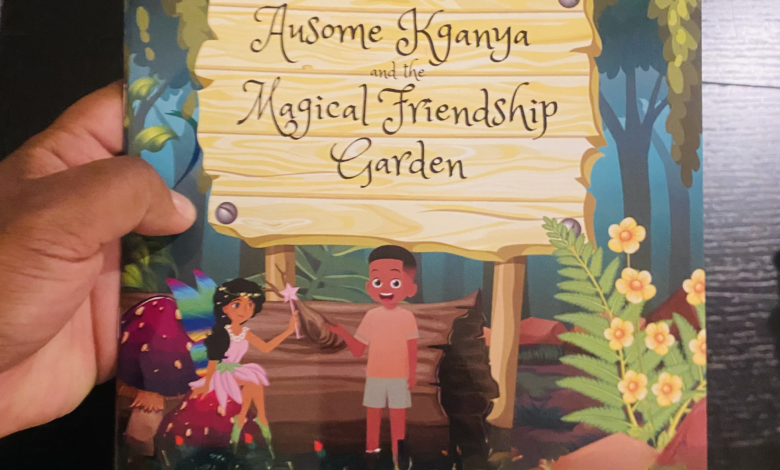Interview with Tshepy Malope, Author of “Ausome Kganya and the Magical Friendship Garden”

Interview with Tshepy Malope, Author of “Ausome Kganya and the Magical Friendship Garden”. She describes herself as just a village girl from Botlokwa with a pen and paper, in love with folklore stories. Tshepy Malope has thus taken her passion and turned it into profit.
The talented author has just dropped her latest book, titled, Ausome Kganya and the Magical Friendship Garden. One of the greatest thing about this read is that it brings awareness to autism spectrum disorder (ASD). We recently had a sit down with Tshepy, as she took us through her book, and how it will benefit readers.
- What inspired you to write “Ausome Kganya and the Magical Friendship Garden”?
Writing “Ausome Kganya and the Magical Friendship Garden” was a labour of love inspired by my
need to create awareness around autism spectrum disorder and address the findings of the
International Reading Literacy Study report which shows that 82% of our learners in grade 4 cannot
read for meaning. I wanted to create a story that will be easy to read, entertains children and
imparts essential lessons about friendship, kindness, and inclusion.
- Can you tell us a little bit about the main character, Ausome Kganya? What makes him special?
Kganya is a 10-year-old boy who has been diagnosed with autism spectrum disorder (ASD). One of
the challenges that is very common with children on the spectrum is the lack of social skills, although
this does not apply to every child (which is why it is called a spectrum). What makes him special is his
ability to find joy in the simplest things and his deep desire to share his adventures and kindness
with others despite his challenges.
- What is the Magical Friendship Garden, and what role does it play in the story?
The Magical Friendship Garden is a beautiful, enchanted place where Kganya meets Palesa, the
Friendship Fairy. It’s filled with magical flowers that teach important values like listening, courage,
kindness, and patience. This garden is central to the story as it provides Kganya with the qualities he
needs to make friends and change his life and those around him. In the literal form, the garden is our
hearts.
- What themes or messages does the book aim to convey to young readers?
The book aims to convey the importance of inclusion, friendship, and the magic that happens when
we celebrate our differences. It teaches young readers about the importance of understanding,
patience, and the value of being a good friend. More often children with autism are labelled as rude
and unfriendly because they rarely show emotion, therefore other children ignore them as though
they do not exist whereas all they need is a little nudge to feel comfortable.
- How does the book celebrate diversity and inclusivity?
Diversity and inclusivity are celebrated through Kganya’s character. He is autistic and shows how his
unique perspective enriches not only his life but also the lives of his friends. The story emphasises
that everyone has something valuable to offer, and friendship and kindness can bridge any gap.
- What age group is the book intended for, and what reading level is it written at?
The book is perfect for children aged 8-10 years old. It’s written in an engaging and simple language
that captures the imagination of young readers while conveying important messages. The age group
was intentional for me, as this is the group that struggles to read for meaning. The percentage of
children in this age group who are unable to read at all has doubled from 13% in 2016 to 27% in
- Learners in the poorest 70% of schools are now 10 times less likely to read for meaning
compared with the wealthiest 10%, widening the educational gap. This is the group that we need to
focus on and I dream that this book reaches them. - How did you come up with the idea for the story, and what was the writing process like?
The idea for the story came from watching children play and seeing the need for stories that
celebrate diversity and teach social-emotional skills. One particular incident included a boy I noticed
playing alone every time I took my toddler to the play area at our estate. Upon approaching him and
striking a relationship, I realized he was super smart and had so much to share, however, he
struggled to approach children his age at the park, and they too looked at him as though he was
weird. Not to say he has autism because I do not know him that well, however, this is a trait most
autistic children share, the inability to socialize. The writing process was a journey of combining
creativity with a purpose. It involved creating a magical yet relatable world where children can see
themselves and learn valuable lessons.
- Are there any personal experiences or memories that you drew upon when writing the book?
Absolutely. My experiences with children, especially those with unique perspectives like autism,
greatly influenced Kganya’s character and the story’s themes. Observing their interactions,
challenges, and triumphs provided a rich source of inspiration. As I mentioned above the story of the
little boy at the playground was personal to me.
- How does the book incorporate elements of South African culture, if at all?
The book is set in Lethabong, with characters of different races reflecting a typical South African
community. The names of the characters, the natural environment, and the cultural values of
ubuntu (community and togetherness) are all elements that incorporate South African culture into
the story.
- What do you hope young readers will take away from reading “Ausome Kganya and the Magical
Friendship Garden”?
I hope young readers take away the importance of kindness, inclusivity, and the magic of friendship.
I want them to understand that everyone has something to offer and that by embracing our
differences, we can create a more loving and understanding world. More and more children are
diagnosed with autism, so I also wanted to create awareness around the spectrum itself, that
children with autism aren’t unfriendly, they just need a little more understanding.
- Are there any plans for a sequel or further books featuring Ausome Kganya?
Yes, there are plans for more books featuring Ausome Kganya. I’m excited to continue exploring his
adventures and the lessons he learns, providing more stories that celebrate diversity and teach
important values. Also, this is not my first book, though it is the first to be published. As a first-time
mom who grew up amongst books, I too wanted to raise my son amongst books. When I started
writing, it was strictly for my son. It was my husband who encouraged me to share my books with
others. I started by narrating folktales my grandmother used to narrate for us when we were young.
We would sit around the fire and she’d tell us stories about Tselane le ledimo and why dassies do
not have tails amongst other stories.
- How can parents, educators, or caregivers use “Ausome Kganya and the Magical Friendship
Garden” as a tool for teaching children about important social-emotional skills or values?
Parents, educators, and caregivers can use the book to start discussions about inclusion, empathy,
and friendship. The magical elements and relatable characters make it a fun and engaging way to
teach children about listening, courage, kindness, and patience. Activities like recreating the magical
garden or discussing the story’s lessons can help reinforce these values in a meaningful way.




